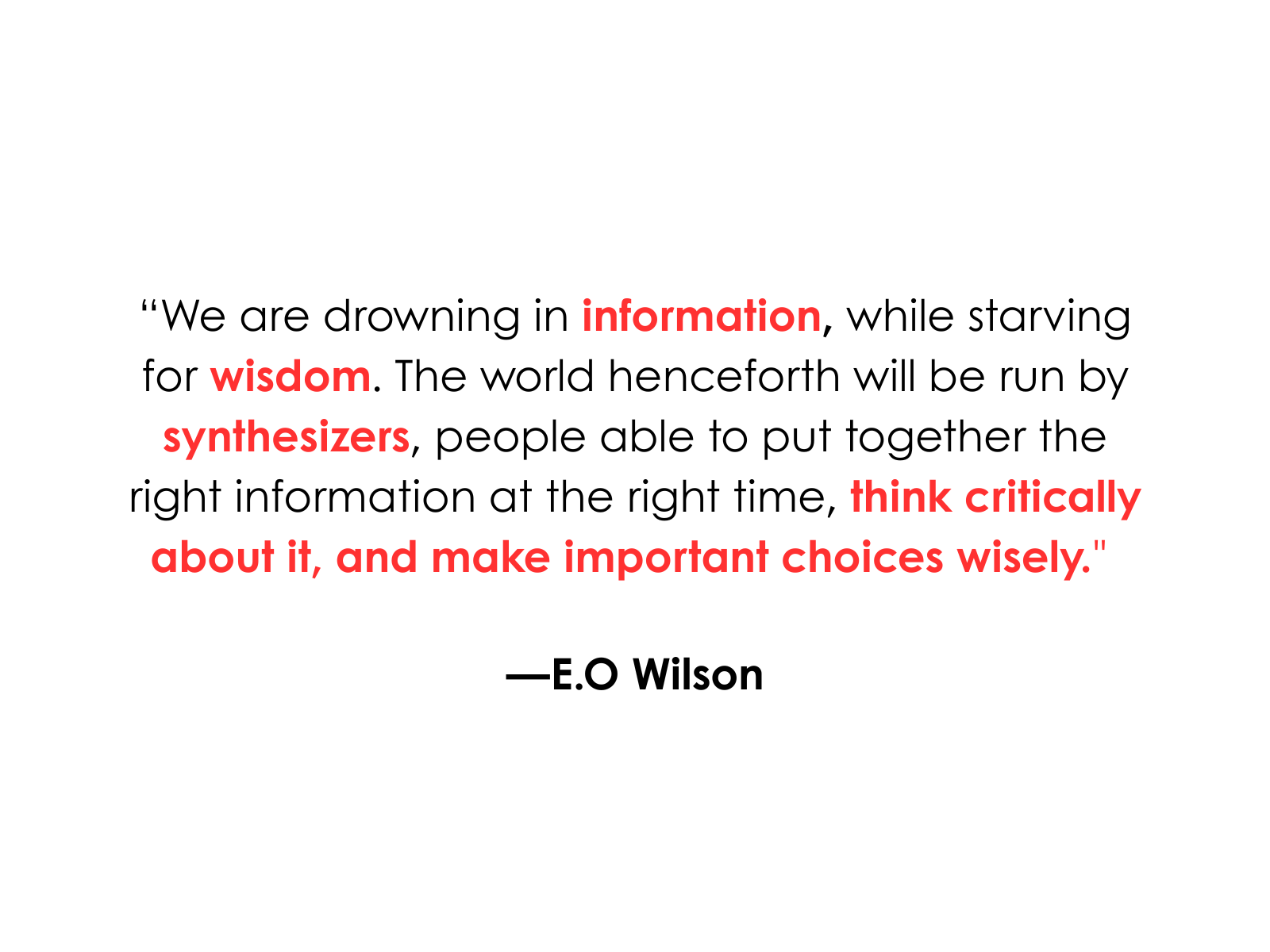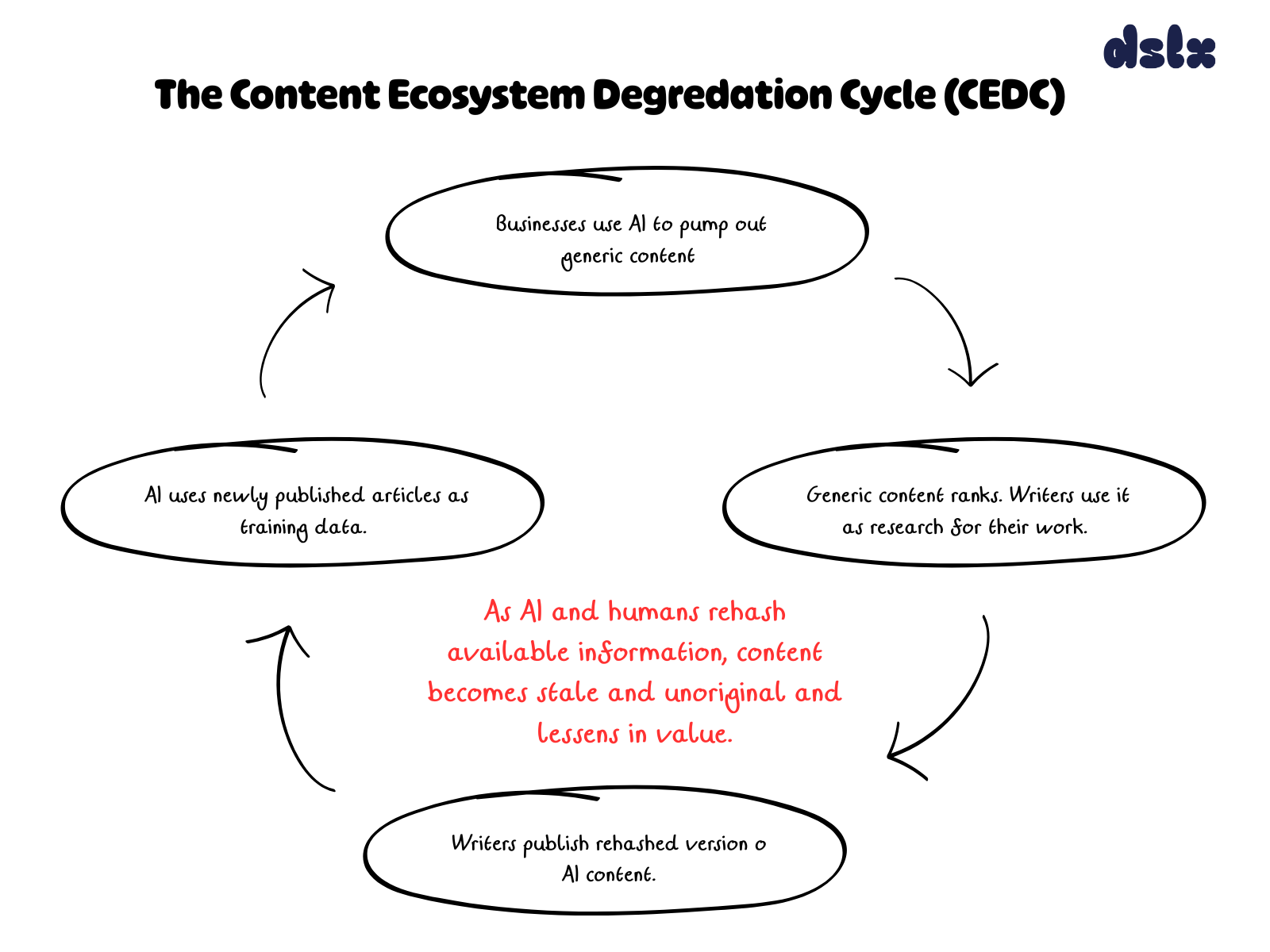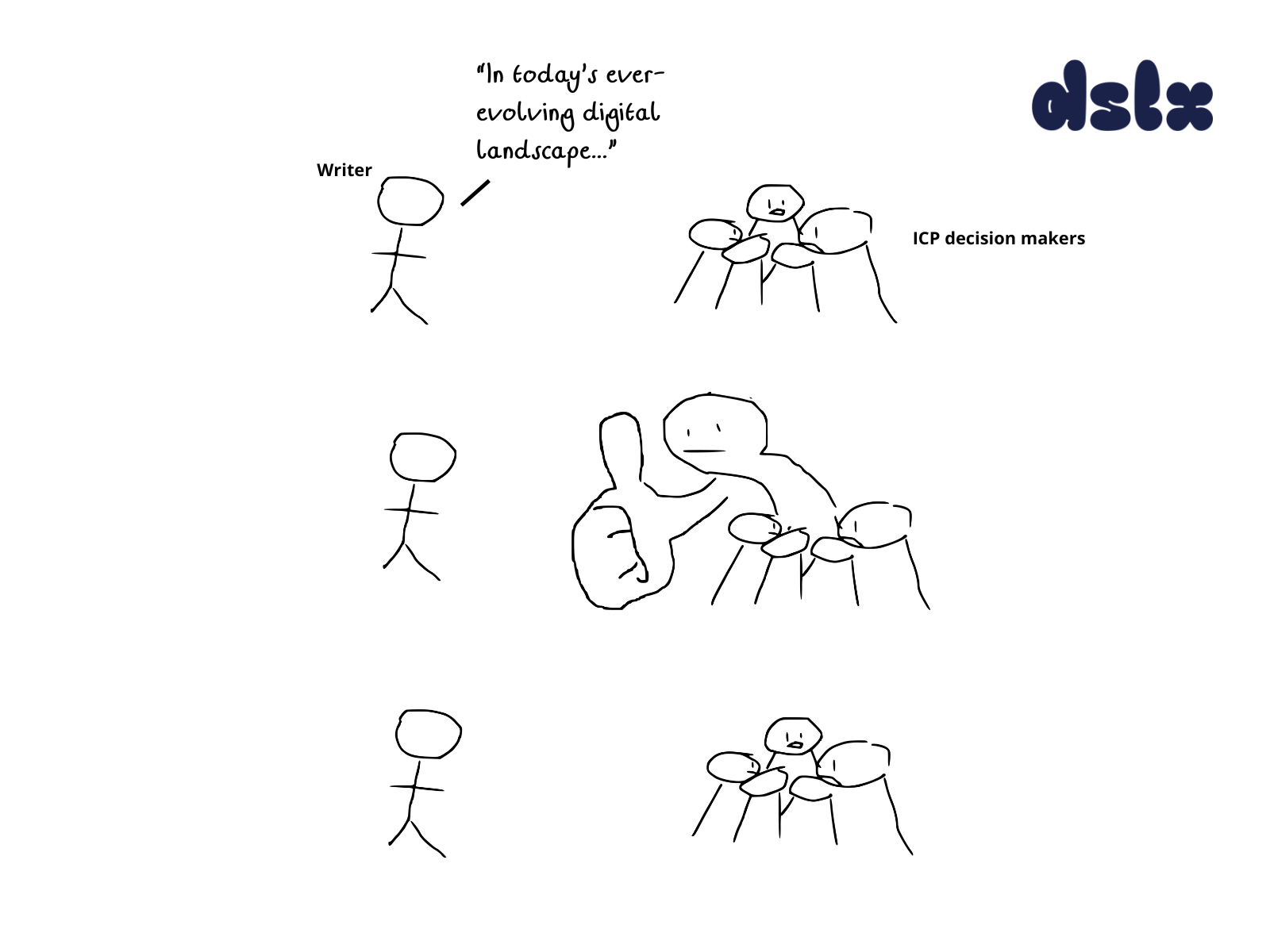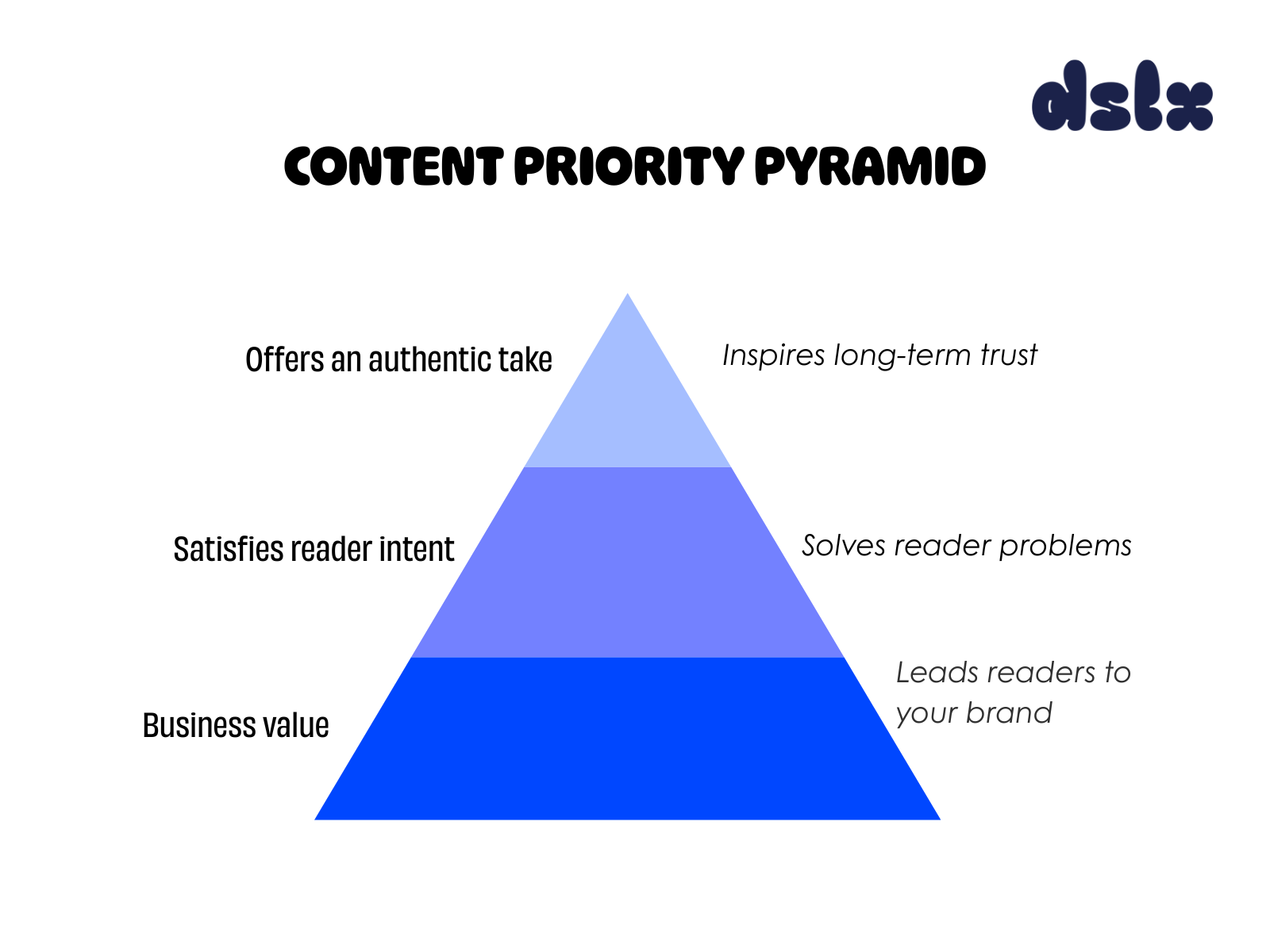Just before sitting down to write this post, I googled the question “How do I write good SaaS content?”
Not because I wanted tips—but to prove a point (to myself, mostly, dear reader, and now, to you if I dare be so bold).
Then, I opened the first four articles ranking in the SERPS.
What struck me wasn't the fact that each article had similar sections. Rather, all the posts read like they were written by the same exact person. From hooks to transitions—all appeared a rehash, of a rehash, of a…you get the picture.
You can recreate the same experiment with similar results—just Google any term.
It’s enough to leave any content writer nervously eyeing one of the many elephants in the room:
🐘 Is this AI's fault?
🐘 How the hell did we get here?
🐘 Is there a better way to write blogs?
🐘 Why does most content seem so dry?
🐘 Why does the front page of Google seem like one giant echo chamber?
In this article, I propose authentic content as a solution to the problems both content writers and, by extension, businesses are dealing with. I’ll tackle each and every content elephant trampling around all our heads. But first, a little history.
H2: Where we are and how we got here
Before we tackle content today, let's travel back in time.
When ChatGPT came out? Farther.
The early 2000s? Farther.
During the creation of the first computer? Even farther.700 AD? Perfect.
Sometime during the Middle Ages, general literacy was reserved for a very small elite class. There weren’t many writers because not many people could read.
The challenge wasn’t finding the right information—it was finding any information at all.
It wasn’t until markets emerged, notaries drafted contracts, and universities began teaching that a literate middle class developed.
(A lot of other stuff happened, which we’ll skip for simplicity’s sake.)
Fast forward to the printing press in the 1450s, and people could write and publish on a much greater scale.
Later came the mass literacy era. Public schools and cheap newspapers took adult literacy to an all-time high. Then, the upcoming information age made writing and reading accessible to just about anyone who had a computer or a smartphone.
As information became democratized, more people have been contributing to a never-ending conversation on just about everything. This includes everything from books to blog posts.
In comes generative AI: Now robots are in on the conversation, too.
This marks a massive shift in the information ecosystem spanning since the first written word. Collectively, we used to face a drought of knowledge. We had to dig for it or create it ourselves through trial and error.
Now, we have so much information that it’s hard to find real, actionable, and valuable content.
As algorithms continue to flood the internet with cookie-cutter blog posts and generic tips, the content ecosystem suffers. We replicate it and use it as our new base—further deteriorating our quality of knowledge. In fact, roughly 57% of content online is generated by AI.
It’s a little like what the biologist Edward Osborne Wilson pointed out:

Nowadays, what would you trust more? A marketing email containing a screenshot of a CEO’s messy, typoed notes, or a neatly keyword-stuffed blog article named: The 7 ultimate tips to create a 7-figure business.”
That’s precisely where authentic content comes in to clean up.
Why write authentic content?
First, let’s get clear on what I mean by authentic content. There’s no hard, fast definition here. That’s because authenticity comes from the inside, and it will look different for different people.
Typically, it’s characterized by uniqueness, honesty, and a genuine approach toward providing a solution or information.
You may also recognize authentic content by the way it resonates with readers. It cuts through the fluff. Brings something different to the conversation.
It’s fresh. It’s memorable. And here’s how it can help you become a better writer.
1. Differentiate yourself in a saturated market
It doesn’t take more than a quick scroll through your LinkedIn to see how many freelance writers are looking for work. And with many LinkedIn content writer job postings, you’re likely to see applicants fill up in a matter of minutes.
If you’re pitching to potential clients and agencies, authentic content will help you stand out and differentiate your personal brand.
Remember when I said authentic content looks different for everyone? It’s precisely that individuality that works in your favor.
With your own voice, tone, and unique angle, you have the chance to impress decision-makers and win over deals or jobs. I'll explain exactly how later in this article. After all, a unique angle can unlock new value for your readers and, by extension, the business you wish to work with.
2. Authenticity builds trust
Authenticity, by nature, means being honest with others and true to one’s own values and standards. Authentic people (and writers) don’t shy away from telling the truth.
The same can’t be said for most business messaging out there. Authentic content serves as the foundation of trust. If it could talk, it would say:
“I won’t sugarcoat and tell you what you want to hear. I’m not here to make a quick buck. I’m here to give you the answers to your questions and help you solve a problem. And I intend to do it with all the skills, research, and means at my disposal.”
I don’t know about you, but that’s definitely someone I would trust with my business.
3. Clean up the AI-trashed content ecosystem
The way the world writes content now isn’t sustainable.
Part of it has to do with resource-stretched marketing teams using AI to pump out generalized blog posts.
Some of this stuff makes it to the top of the SERPS, and by extension, in the research of many content writers. They then rehash the same regurgitated information and publish a post, before AI takes that post for new training data.
It’s a vicious circle leading to what I call the content ecosystem degradation cycle (CEDC). And we’re all worse off. Businesses make decisions based on generalized information, and writers are fast losing the sources necessary for writing great content.

The remedy? We need to start “planting” authentic content that changes the game, heightens the bar, and makes a difference. It’s either that, or settle for a standard that hurts both businesses and writers with low-quality, often false information.
4. Authenticity is thought leadership by default
If you’re being authentic, you’re going to say something different. It’s unavoidable. You might agree with most of the information out there, but even that offers an opportunity to think critically about that source material before confirming it.
Plus, you can always invite differing opinions on your blogs (I’ll explain how below) or dissect problems from an angle, level, or depth that’s unavailable elsewhere.
Given there are so many content replicants in the world, your piece will stand out like a sore thumb—and that’s a good thing. Unless you want it to end up with little more than a thumbs up.

A quick case against writing authentic content
Don’t think that writing authentic content means going against your client’s ToVs and blasting hot takes left and right.
While this can certainly get you some eyeballs, it doesn’t always get you the best attention—or a retainer. This is because authenticity (differentiation) comes after impact and service.
Your first main objective should always be serving your client. To serve your client, you need to serve your reader. Solutions first, authentic content second. For that, you need to include messaging that moves the needle on important business goals.
Offering a unique and novel approach only works as long as you’re providing real value. Nobody will pay you for just being yourself. (trust me, I tried.)
Plus, some topics aren’t open to innovation. There’s well-researched content out there that isn’t subject to much change. Other industries, like tech, for example, change every day, and so does our perception of them.

How to write in your own voice: 5 strategies for an unmistakable signature
You’ve probably heard the maxim “just be yourself.” all the time. And it applies to writing just as much as it does to everyday life. Trouble is, we’re taught that being ourselves isn’t beneficial. That’s why we need to relearn, realign, and relean into that state.
Here’s how to do it in your writing.
1. Write from nuanced angles or feature someone who does
There are probably millions of articles that tell you how to start a business. And rightfully so, there’s so much broad room for exploration that there are all kinds of answers.
Are you looking to start an LLC? B2B? A VC-backed startup? How about the world’s first mechanical pigeon that takes dumps on cars that cut you off or take your parking space?
The possibilities are endless.
Sure, you can be broad and write TOFU articles as starting material, but there's plenty of those out there floating on the web already.
All the more reason to create a unique angle others aren’t covering.
If you don’t have the experience (firsthand) to back it up, find someone who does, interview them, and thread their insights throughout your article.
You might have heard this labeled as thought leadership content. Turns out, that’s just a fancy word for having your own darn opinion POV through lived experience—AKA authenticity.
The key to this strategy: Make your SME’s insights the center of your story, instead of a supplement. If you can’t directly offer an authentic solution, your writing should be a mouthpiece for someone who can. Don't position it just another “how to” but as a deep dive into your founder’s journey.
H3: 2. Be fu*king honest
The ultimate, comprehensive, conclusive guide to anything worth researching doesn’t exist.
Why?
Because it implies that the article has all the information you could possibly need. No further research necessary.
Have you ever read such a thing? I sure haven’t.
And while this sounds like a good deal for the reader and communicates value—altogether, it isn’t honest, and therefore not authentic.
Being honest, all comes down to delivering what you’re promising in your headline, being transparent, and giving your reader real value. One way to do this is by shunning buzzwords and double-checking your work for cliches or jargon.
If you write content with new ideas and original research with your SME at the center, you won’t need to position your piece as the “game-changing guide to x” or the “ultimate list of y.”
You’ll be much more concerned with communicating things as they really are rather than fluffing them up for a few extra seconds of skim time.
Another way of upholding honesty is by including both your wins and your losses within your writing.
What challenge were you really facing that prompted you to use the platform you’re writing about?
Creating an in-depth how-to guide on marketing strategies?
Give us the gory details on how your first marketing strategy crashed and burned.
The experience and lessons you learn from that failure make your content more real, relatable, and trustworthy than 99% of the gurus out there.
3. Make New Connections
New, creative, and authentic ideas take hold when you connect two things that aren’t apparently related. That’s the working basis for all new ideas, and you can use experiences, hobbies, ideas, and lessons from your own life to thread them into your content.
Since everyone’s experiences and perceptions are widely different, this strategy will help your content truly stand out.
That E.O Wilson quote I mentioned earlier was on a book about the natural sciences–not AI or marketing. In my piece on RX writing, I combined my knowledge in UX research and design to create a new system for writing reader-centric content.
You never know when your experience in a seemingly different field can inform the content you write about.
4. Write your own ToV
Businesses have tone of voice documents—it would only make sense that writers would too. This can especially come in handy when you’re creating your own portfolio website.
A detailed ToV voice is like your own accountability buddy. You can use it to check if you’re matching your intended style. What do you want to sound like? What type of writing most resonates with you?
When do you feel like you’re writing content as you, rather than a no-name business?
Load it up with adjectives, word choices, grammar considerations, and examples. The more detailed, the better. Consider it a live document, subject to change and growth.
For example, the adjectives I aim to communicate in my writing are:
- Bold
- Direct
- Sincere
- Creative
- Genuine
- Insightful
- Pragmatic
- Passionate
- Empowering
- Conversational
Learn to put yourself in your writing with dslx
The truth is, it’ll take you more than one skimmed article to effectively and strategically communicate authentically in your writing.
And that’s okay, learning to put yourself in your writing is an unfolding process. It’s fun and definitely beneficial because it sets you apart from fluffy, AI-generated content. And at dslx, we’re here to help you every step of the way.
That’s why we’ve created the dslx Academy.
Think of it as a full-scale upskilling portal where writers can take micromasterclasses, get cheat sheets for powerful writing, and 3 week courses for in-depth learning. I even completed many of the courses when I was just starting out.
Join the dslx Academy and charge more for your mind.


